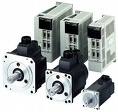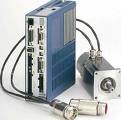Use of servo drives in equipment automation
Technological progress and competition lead to continuous growth in productivity and an increase in the degree of automation of technological equipment. At the same time, the requirements for adjustable electric drives are increasing in terms of such parameters as speed control range, positioning accuracy and overload capacity.
In order to meet the requirements, high-tech devices of modern electric drive - servo drives - have been developed. These are drive systems that, in a wide range of speed control, guarantee highly precise movement processes and realize their good repeatability. Servo drives are the most advanced stage of electric drives.
DC to AC
For a long time, DC motors were mainly used in controlled drives. This is due to the simplicity of applying the armature voltage control law.Magnetic amplifiers, thyristor and transistor regulators were used as control devices and analog tacho generators were used as a speed feedback system.
The thyristor electric drive is a controlled thyristor converter that supplies power permanent engine… The power circuit of the electric drive consists of: a matching transformer TV; controlled rectifier assembled from 12 thyristors (V01 … V12) connected in a six-phase half-wave parallel circuit; current limiters L1 and L2 and DC motor M with independent excitation. Three-phase transformer The TV has two supply coils and a coil shielded from them to supply control circuits. The primary winding is connected in a delta, the secondary winding in a six-phase star with a neutral terminal.
The disadvantages of such a drive are the complexity of the control system, the presence of brush current collectors, which reduce the reliability of the motors, as well as the high cost.
Advances in electronics and the emergence of new electrical materials have changed the situation in the field of servo technology. Recent advances make it possible to offset the complexity of AC drive control with modern microcontrollers and high-speed, high-voltage power transistors. Permanent magnets, made of neodymium-iron-boron and samarium-cobalt alloys, due to their high energy intensity, significantly improved the characteristics of synchronous motors with magnets on the rotor, while reducing their weight and dimensions. As a result, the dynamic characteristics of the drive have improved, and its dimensions have been reduced.The trend towards asynchronous and synchronous AC motors is particularly noticeable in servo systems, which have traditionally been based on DC electric drives.
Asynchronous servo
 The asynchronous electric motor is the most popular in the industry due to its simple and reliable design at a low cost. However, this type of motor is a complex control object in terms of torque and speed control. The use of high-performance microcontrollers that implement the vector control algorithm and high-resolution digital speed sensors allow to obtain the speed control range and the accuracy characteristics of an asynchronous electric drive, no worse than that of a synchronous servo drive.
The asynchronous electric motor is the most popular in the industry due to its simple and reliable design at a low cost. However, this type of motor is a complex control object in terms of torque and speed control. The use of high-performance microcontrollers that implement the vector control algorithm and high-resolution digital speed sensors allow to obtain the speed control range and the accuracy characteristics of an asynchronous electric drive, no worse than that of a synchronous servo drive.
Frequency-controlled AC induction drives change the speed of the squirrel-cage induction motor shaft using transistor or thyristor frequency converters that convert a single-phase or three-phase voltage with a frequency of 50 Hz to a three-phase voltage with a variable frequency in the range of 0.2 to 400 Hz .
Today frequency converters is a device of small size (much smaller than an asynchronous electric motor of similar power) on a modern semiconductor basis, controlled by a built-in microprocessor. Variable asynchronous electric drive allows you to solve various problems of production automation and energy saving, in particular the stepless regulation of the speed of rotation or the speed of feed of technological machines.
In terms of cost, the asynchronous servo drive has an undisputed superiority at high powers.
Synchronous servo
 Synchronous servo motors are three-phase synchronous motors with permanent magnet excitation and a photoelectric rotor position sensor. They use squirrel cage or permanent magnet rotors. Their main advantage is the low moment of inertia of the rotor compared to the developed torque. These motors work in combination with a servo amplifier comprising a diode rectifier, a capacitor bank and an inverter based on power transistor switches. To smooth out the ripple of the rectified voltage, the servo amplifier is equipped with a block of capacitors and to convert the energy accumulated in the capacitors at the moments of braking — with a discharge transistor and ballast resistance, which provides effective dynamic braking.
Synchronous servo motors are three-phase synchronous motors with permanent magnet excitation and a photoelectric rotor position sensor. They use squirrel cage or permanent magnet rotors. Their main advantage is the low moment of inertia of the rotor compared to the developed torque. These motors work in combination with a servo amplifier comprising a diode rectifier, a capacitor bank and an inverter based on power transistor switches. To smooth out the ripple of the rectified voltage, the servo amplifier is equipped with a block of capacitors and to convert the energy accumulated in the capacitors at the moments of braking — with a discharge transistor and ballast resistance, which provides effective dynamic braking.
Variable frequency synchronous servo drives respond quickly, work well with pulse-programmed control systems, and can be used in a variety of industries where the following drive qualities are required:
-
positioning of working bodies with high accuracy;
-
maintaining torque with high accuracy;
-
maintaining movement speed or feeding with high accuracy.
The main manufacturers of synchronous servomotors and variable drives based on them are Mitsubishi Electric (Japan) and Sew-Evrodrive (Germany).
Mitsubishi Electric manufactures a range of low power servo drives -Melservo-C in five sizes with rated power from 30 to 750 W, rated speed 3000 rpm and rated torque from 0.095 to 2.4 Nm.
The company also manufactures medium-power gamma-frequency servo drives with rated power from 0.5 to 7.0 kW, rated speed from 2000 rpm and rated torque from 2.4 to 33.4 Nm.
Mitsubishi's MR-C series servo drives successfully replace stepper motors because their control systems are fully compatible (pulse input), but at the same time they are free from the disadvantages inherent to stepper motors.
 MR-J2 (S) servo motors differ from others with the built-in microcontroller with extended memory, which contains up to 12 control programs. Such a servo drive operates without loss of accuracy over the entire range of operating speeds. One of the significant advantages of the device is its ability to compensate for "accumulated errors". The servo amplifier simply resets the servo motor "to zero" after a certain number of duty cycles or on a signal from a sensor.
MR-J2 (S) servo motors differ from others with the built-in microcontroller with extended memory, which contains up to 12 control programs. Such a servo drive operates without loss of accuracy over the entire range of operating speeds. One of the significant advantages of the device is its ability to compensate for "accumulated errors". The servo amplifier simply resets the servo motor "to zero" after a certain number of duty cycles or on a signal from a sensor.
Sew-Evrodrive supplies both individual components and complete servo drives with a full range of accessories. The main application areas of these devices are actuators and high-speed positioning systems for programmed machine tools.
Here are the main features of Sew-Evrodrive synchronous servo motors:
-
starting torque — from 1 to 68 Nm, and in the presence of a fan for forced cooling — up to 95 Nm;
-
overload capacity — the ratio of maximum torque to starting torque — up to 3.6 times;
-
high degree of protection (IP65);
-
thermistors built into the stator winding control the heating of the motor and exclude its damage in case of any kind of overload;
-
pulsed photoelectric sensor 1024 pulses/rev. provides a speed control range of up to 1:5000
Let's draw conclusions:
-
in the field of adjustable servo drives, there is a tendency to replace DC electric drives with analog control systems with AC electric drives with digital control systems;
-
adjustable asynchronous electric drives based on modern small-sized frequency converters allow solving various problems of production automation and energy saving with a high degree of reliability and efficiency. It is recommended that these drives be used for smooth adjustment of the feed rate in woodworking machines and machines;
-
asynchronous servo drives have indisputable advantages over synchronous ones at high powers and torques above 29-30 N / m (for example, spindle rotation drive in peeling machines);
-
if a high speed is required (the duration of the automatic cycle does not exceed a few seconds) and the value of the developed torques is up to 15–20 N / m, adjustable servo drives based on synchronous motors with different types of sensors should , which make it possible to adjust the speed of rotation up to 6000 rpm without reducing the moment;
-
Variable frequency servo drives based on AC synchronous motors allow the creation of fast positioning systems without the use of CNC.
How to properly install and align the engine
Methods of diagnosing malfunctions of asynchronous electric motors
How to turn on a three-phase electric motor in a single-phase network without rewinding
Types of electrical protection of asynchronous electric motors
Thermistor (posistor) protection of electric motors
How to determine the temperature of the windings of AC motors by their resistance
How to improve power factor without compensating capacitors
How to prevent damage to the insulation of the stator winding of an induction motor
How the parameters of a three-phase induction motor change under conditions other than nominal
